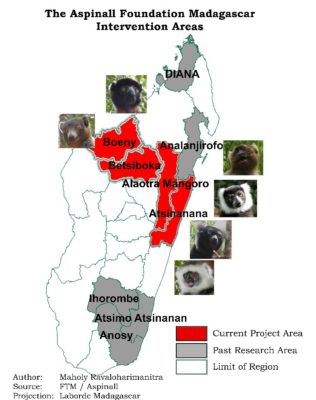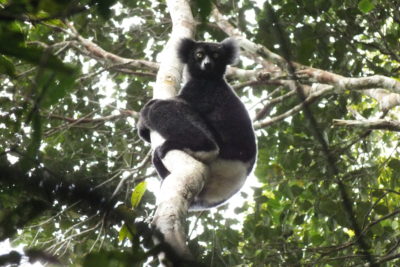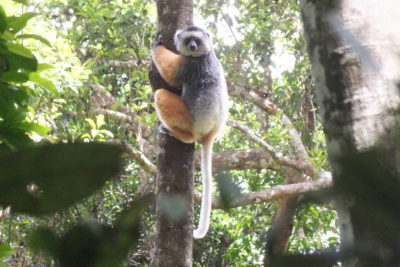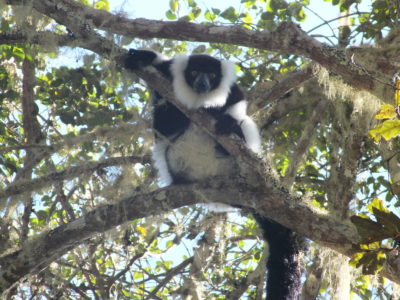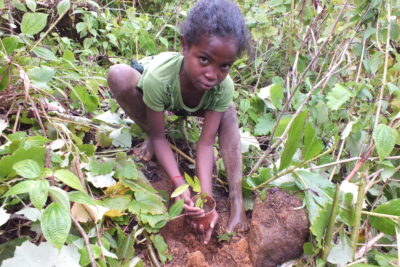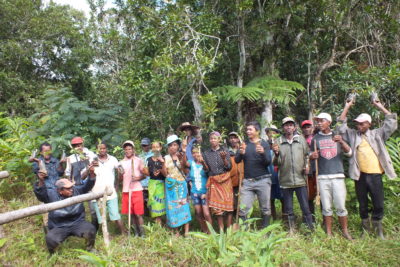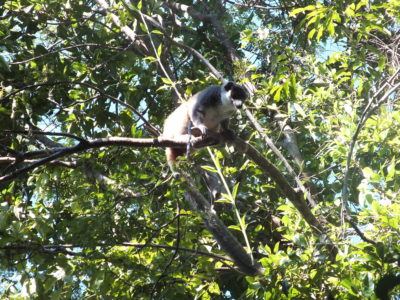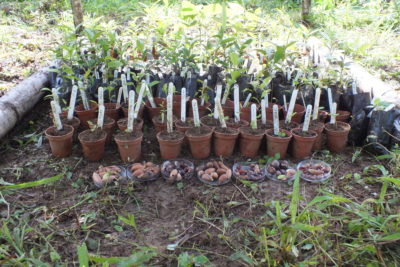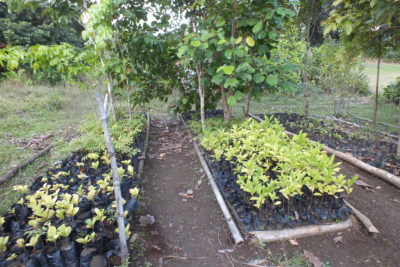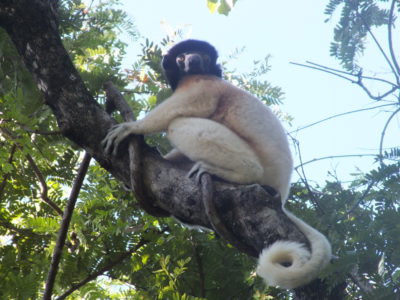March 2019 is dedicated to the Aspinall Foundation. We interviewed Maholy Ravaloharimanitra, National Representative of Madagascar of Aspinall Foundation, who tells us about their important work and how we can support them.
Tell us about the history of Aspinall Foundation.
Our Aspinall Foundation Madagascar program started in 2009 and focused, primarily, on gathering local knowledge about the distribution of the greater bamboo lemur, which had recently been re-discovered in Torotorofotsy.
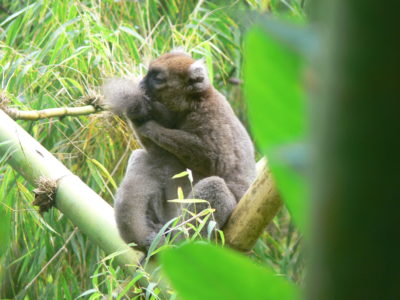
After the initial research, we were able to prioritise sites where the presence of these lemurs was confirmed. In 2010, we extended our research to include crowned sifaka and started to explore the area where they might occur in the west of Madagascar.
To date, we are working actively for the conservation of 6 critically endangered lemur species and their habitat. Namely, the greater bamboo lemur, the black and white ruffed lemur, the Indri, crowned and diademed sifaka and the mongoose lemur.
Since 2016, we have also extended our interest to other taxa, such as fishing eagles, big headed turtles, Madagascar heron and some fish species.
Since The Aspinall Foundation Madagascar Project started, we have been collaborating with different partners, local and international. These include: Conservation International, GERP (Groupe d’Études et de Recherche sur les Primates de Madagascar), Association Mitsinjo, University of Antananarivo, University of Mahajanga, ENS (Ecole Normale Supérieure) Ampefiloha, Beauval Conservation, CERZA Conservation, CEPF, SOS Lemur, alongside the ministry responsible for the environment and its local representatives and the ministry responsible for fisheries and its local representatives.
Where is Aspinall Foundation located?
We work in many regions of Madagascar. We are currently working with:
- 5 local community associations (VOI) within the forest corridor of Ankeniheny Zahamena (CAZ) in Alaotra Mangoro Region,
- 5 VOI within Andriantantely forest,
- 3 VOI around Andriantantely forest,
- 1 private property in Atsinanana Region,
- 1 VOI within Anaboazo forest in Boeny Region, and
- 4 other VOI in Betsiboka Region.
Which lemur species do you work with?
We are currently working with 6 critically endangered species: indri, diademed sifaka, black and white ruffed lemur and greater bamboo lemur in the eastern (Ambatondrazaka, Moramanga, Brickaville and Mahanoro); crowned sifaka and mongoose lemur in the western (Maevatanana and Ambato Boeny, MAB).
How does Aspinall Foundation help lemur conservation?
Our activities can be classified into 2 main components: 1) the practical part, where we work on local communities’ commitment to conservation; and 2) and the scientific part, where we are monitoring the evolution of lemur populations, the distribution of these populations, and their behavior.
Building a Local Community Commitment to Conservation
Awareness Raising and Education Through Festivals
The major conservation issues in our area are that people don’t know the value of the biodiversity surrounding them and how it impacts their lives. We have chosen 2 major world days to raise people’s awareness:
- The World Environment Day which aims to educate people about how important forest areas are to their daily lives and how vital forests are for human survival.
- The World Lemur Festival, which aims to encourage communities to discover why conserving lemurs is so important and what they can do, to help protect lemurs from extinction threats.
In the early part of this year, we are considering becoming involved in The World Wetland Day, which will take place annually in February, for the western part of our activities.
Awareness Raising and Education With Students
As we are targeting communities with people of very different ages, we are actively involved with education and awareness raising with pupils: they learn about tree nursery and reforestation during the official Day For Schools (Journée des écoles) which is held every February. We distribute writing books with conservation messages to the pupils and share calendars with conservation messages to parents, authorities and members.
Supporting and Facilitating Community-based Conservation
We support three main community-based conservation programs:
- Conservation activities implemented by 14 local communities and the forest part of the NAP Nosivolo in 3 regions of Madagascar, which makes around 20,600 ha in total.
- Monitoring and patrolling activities, part of which are co-financed by SOS (eastern part of our project) and by CEPF (western part of our project). This activity is directly improving the livelihood of at least 73 families.
- Law enforcement, surrounding each transfer of management areas, in collaboration with the Gendarmerie of our intervention areas, as well as the regional or local representation of the ministry responsible for forestry.
Threats Mitigation
We are helping local communities to improve their livelihood and income through different areas, which might be technical or financial and according to their request. This year, and in collaboration with SOS, we supported fish farming, rice growing, ginger plantations, bee keeping and market gardening for VOI within CAZ and Andriantantely sites.
Our Work in Lemur Ecology and Population Monitoring
- From 2009 to 2012, we focused on greater bamboo lemurs and crowned sifaka.
- From 2012, we have extended our interest into 4 other critically endangered species, including black and white ruffed lemur, indri, mongoose lemur and diademed sifaka.
- In 2018, we started to investigate nocturnal species within CAZ project area.
We are focusing on lemur distribution and abundance, which allows us to monitor lemur populations and behavior evolution over time, to see how our conservation projects impacted them
Surveying Wetland for Endemic and Threatened Birds, Freshwater Turtles and Fish Species
Since 2016, and with CEPF funding, we have extended our activities and research interests to other important native species such as birds, freshwater turtles and fish in the western part of our project.
The western part of our project is focusing on ecosystems and landscapes rather than just focal species. However, our interventions are oriented by the presence or absence of endemic and threatened bird species, including the fishing eagle, the Madagascar heron, or the Madagascar grebes, freshwater turtle species, such as the big headed turtle and fish species, such as damba.
What are some of Aspinall Foundation’s recent achievements?
Focal Species Ecology and Population Monitoring
Number of group (Grp.) and individuals (Ind.) per focal species per group of sites
| Species | CAZ[1] | ADTL[2] | MAB[3] | NSVL[4] | Total | |||||
| Grp. | Ind. | Grp. | Ind. | Grp. | Ind. | Grp. | Ind. | Grp. | Ind. | |
| Prolemur simus Greater Bamboo Lemur |
10 | 92 | 21 | 519 | 1 | Unkw | 32 | 611 | ||
| Varecia variegata Black-and-white Ruffed Lemur |
24 | 93 | 85 | 337 | 109 | 403 | ||||
| Indri indri Indri |
62 | 161 | 110 | 337 | 172 | 489 | ||||
| Propithecus diadema Diademed Sifaka |
18 | 72 | 28 | 97 | 46 | 169 | ||||
| Propithecus coronatus Crowned Sifaka |
21 | 70 | 21 | 70 | ||||||
| Eulemur mongoz Mongoose Lemur |
6 | 15 | 6 | 15 | ||||||
| Eulemur rufus Rufous Lemur |
4 | 9 | 4 | 9 | ||||||
[1] CAZ = Forest Corridor of Ankeniheny Zahamena
[1] ADTL = Andriantantely Forest and surroundings
[1] MAB = Maevatanana – Ambato Boeny sites
[1] NSVL = Nosivolo New Protected Area
Awareness Raising and Education
- We have celebrated World Environment Day at Ranomainty with VOI Ala Maitso for CAZ and at Tanambao with the VOI Soafaniry Sahamanantsy and VOI Tambatra.
- We have celebrated World Lemur Festival with 3 local community associations of our sites: with Tsiriniala VOI for Andriantantely Project and with Faniry and Mami VOI for CAZ project.
- Supported/helped with building a hospital facility for Raboana (Faniry and Mami VOI)
Supporting and Facilitating Community-based Conservation
- 49 local rangers regularly monitor lemurs within the conservation area of transfer of management. 24 other rangers are carrying out monitoring outside the conservation area of the transfer of management within CAZ project.
- To date 10 tree nurseries are built and functional: 1 within MAB project area, 3 within CAZ project area and 6 within Andriantantely project area
- 36,487 native trees were grown in these tree nurseries
- 16,848 trees from these tree nurseries were transplanted to a reforestation area, which is equivalent to 8.5 ha of area reforested with native species.
- Delineation of the VOI Sahanio in Andriantantely, which is part of the transfer of management process
- No forest fires were observed within the transfer of management of local community associations we are working with, in CAZ project areas.
- We have supported several law enforcement activities, mostly within CAZ and ADTL projects area.
Threats Mitigation
148 families within CAZ project are currently benefiting from fish farming and rice growing project, 78 other families from Andriantantely project, are benefiting from ginger plantations and 170 other families from Andriantantely project area, are benefiting from market gardening, while 35 families from Ambato-Boeny project area, are benefiting from lemon trees and bee keeping donations.
What are some goals and expectations that Aspinall Foundation has for the future?
Goals for Education, Communication and Awareness Raising
- Increase the number of communities we can help raise awareness of the necessity and importance of conservation, especially within MAB sites.
- Keep undertaking capacity building for teachers, enabling them to provide environmental education for schools.
- Organise and undertake awareness raising events such as World Wetland Day, World Environment Day and World Lemur Festival.
- Reiterate the role of each stakeholder in conservation at each site.
Goals for Conservation Actions and Social Outreach
- Achieving 25 ha of reforestation in total for 2018 – 2019
- Finalise the transfer of management contract for one of our local community associations in Ambinanifanasana (CR Fetraomby).
- Survey wetland and forest around MAB project where we have identified 5 local communities to work with for the conservation of important bird species, freshwater turtles, fish and lemurs.
- Continue to build and improve local communities’ capacity for them to become an autonomous manager of natural resources and their association.
- Further involve local communities into conservation actions, through monitoring and patrolling, as well as law enforcement.
Goals for Research
- Improve data and analysis on lemur ecology and population.
- Improve knowledge on the nocturnal lemurs, of our intervention area.
- Translocation of isolated groups of Eulemur rubriventer within the Antsinanana region to Andriantantely
- Extend our actions to 2 other local communities within CAZ: VOI Faniry and VOI Mami.
Do you have volunteer opportunities at Aspinall Foundation?
We do not have volunteering opportunities, due to volunteer requirements (phone connection, internet, nearby hospitals). But, if anyone would be interested in volunteering for permaculture, pest disease management (bio), teaching simple English conversation for teachers, rangers and local guides, please get in touch.
We are also seeking collaboration with universities who are willing to undertake studies with other taxa.
What do you need donations for right now?
There are different ways and infinite possibilities to help us progress with our research and conservations activities. The most urgent are:
- Supporting conservation within Andriantantely forest, starting in April 2019 (the end of the SOS financial support for Andriantantely), including paying local rangers, supporting the capacity building of local community association, research on lemurs, purchasing additional materials like camera-trap, binoculars, GPS to give more accuracy and liability to the research results and know more about Andriantantely biodiversity.
- Financing research and conservation activities within the Nosivolo project, which are currently suspended due to lack of funds.
Secondarily, we would like to raise funds for:
- Building at least 1 classroom per fokontany for the 5 fokontany within Andriantantely forest.
- Building a proper basecamp per site.
- Supporting the exchange between VOI from the 4 different regions.
- Supporting women’s commitment to conservation by valuing handcrafts, market gardening products and livestock farming.

